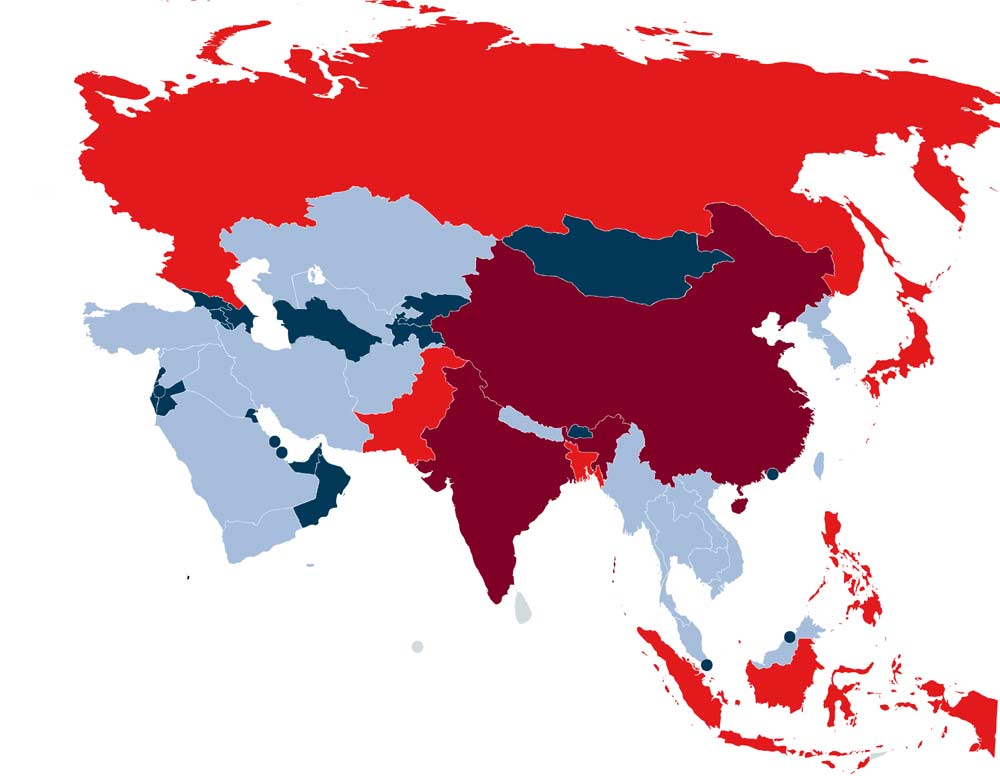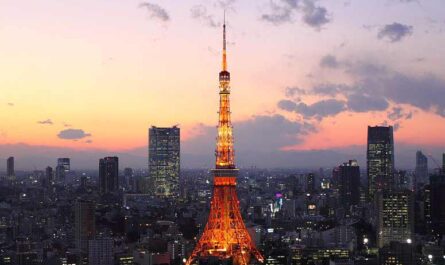Capital Cities in Asia
Capital Cities in Asia (According to Country’s Alphabetic Order)
| Country | Capital City | Population |
|---|---|---|
| Afghanistan | Kabul | 3,678,033 |
| Armenia | Yerevan | 1,076,716 |
| Azerbaijan | Baku | 2,270,030 |
| Bahrain | Manama | 157,474 |
| Bangladesh | Dhaka | 8,906,035 |
| Bhutan | Thimphu | 114,551 |
| Brunei | Bandar Seri Begawan | 50,000 |
| Burma | Nay Pyi Taw | 924,608 |
| Cambodia | Phnom Penh | 1,501,725 |
| China | Beijing | 21,700,000 |
| Cyprus | Nicosia | 116,392 |
| East Timor | Dili | 222,323 |
| Georgia | Tbilisi | 1,113,800 |
| Hong Kong | Hong Kong | 1,253,417 |
| India | New Delhi | 257,803 |
| Indonesia | Jakarta | 10,042,200 |
| Iran | Tehran | 8,846,782 |
| Iraq | Baghdad | 8,765,000 |
| Israel | Jerusalem | 891,977 |
| Japan | Tokyo | 9,508,776 |
| Jordan | Amman | 1,812,059 |
| Kazakhstan | Nursultan | 1,029,556 |
| Kuwait | Kuwait City | 2,779,000 |
| Kyrgyzstan | Bishkek | 976,734 |
| Laos | Vientiane | 783,000 |
| Lebanon | Beirut | 361,366 |
| Macao | Concelho de Macau | 504,300 |
| Malaysia | Kuala Lumpur | 1,839,451 |
| Maldives | Malé | 221,678 |
| Mongolia | Ulaanbaatar | 1,515,593 |
| Nepal | Kathmandu | 975,543 |
| North Korea | Pyongyang | 3,222,000 |
| Oman | Muscat | 630,000 |
| Pakistan | Islamabad | 1,014,825 |
| Palestine | Ramallah | 27,092 |
| Philippines | Manila | 1,780,148 |
| Qatar | Doha | 587,055 |
| Saudi Arabia | Riyadh | 6,506,700 |
| Singapore | Singapore | 5,703,569 |
| South Korea | Seoul | 9,776,305 |
| Sri Lanka | Colombo | 752,993 |
| Syria | Damascus | 2,354,000 |
| Taiwan | Taipei | 2,704,974 |
| Tajikistan | Dushanbe | 778,500 |
| Thailand | Bangkok | 5,686,646 |
| Turkey | Ankara | 5,445,026 |
| Turkmenistan | Ashgabat | 860,000 |
| United Arab Emirates | Abu Dhabi | 1,482,816 |
| Uzbekistan | Tashkent | 2,509,969 |
| Vietnam | Hanoi | 2,316,772 |
| Yemen | Sanaa | 1,937,451 |

Capital Cities in Asia
Capital Cities in Asia (According to Capital’s Alphabetic Order)
| Country | Capital City | Population |
|---|---|---|
| United Arab Emirates | Abu Dhabi | 1,482,816 |
| Jordan | Amman | 1,812,059 |
| Turkey | Ankara | 5,445,026 |
| Turkmenistan | Ashgabat | 860,000 |
| Iraq | Baghdad | 8,765,000 |
| Azerbaijan | Baku | 2,270,030 |
| Brunei | Bandar Seri Begawan | 50,000 |
| Thailand | Bangkok | 5,686,646 |
| China | Beijing | 21,700,000 |
| Lebanon | Beirut | 361,366 |
| Kyrgyzstan | Bishkek | 976,734 |
| Sri Lanka | Colombo | 752,993 |
| Macao | Concelho de Macau | 504,300 |
| Syria | Damascus | 2,354,000 |
| Bangladesh | Dhaka | 8,906,035 |
| East Timor | Dili | 222,323 |
| Qatar | Doha | 587,055 |
| Tajikistan | Dushanbe | 778,500 |
| Vietnam | Hanoi | 2,316,772 |
| Hong Kong | Hong Kong | 1,253,417 |
| Pakistan | Islamabad | 1,014,825 |
| Indonesia | Jakarta | 10,042,200 |
| Israel | Jerusalem | 891,977 |
| Afghanistan | Kabul | 3,678,033 |
| Nepal | Kathmandu | 975,543 |
| Malaysia | Kuala Lumpur | 1,839,451 |
| Kuwait | Kuwait City | 2,779,000 |
| Maldives | Malé | 221,678 |
| Bahrain | Manama | 157,474 |
| Philippines | Manila | 1,780,148 |
| Oman | Muscat | 630,000 |
| Burma | Nay Pyi Taw | 924,608 |
| India | New Delhi | 257,803 |
| Cyprus | Nicosia | 116,392 |
| Kazakhstan | Nursultan | 1,029,556 |
| Cambodia | Phnom Penh | 1,501,725 |
| North Korea | Pyongyang | 3,222,000 |
| Palestine | Ramallah | 27,092 |
| Saudi Arabia | Riyadh | 6,506,700 |
| Yemen | Sanaa | 1,937,451 |
| South Korea | Seoul | 9,776,305 |
| Singapore | Singapore | 5,703,569 |
| Taiwan | Taipei | 2,704,974 |
| Uzbekistan | Tashkent | 2,509,969 |
| Georgia | Tbilisi | 1,113,800 |
| Iran | Tehran | 8,846,782 |
| Bhutan | Thimphu | 114,551 |
| Japan | Tokyo | 9,508,776 |
| Mongolia | Ulaanbaatar | 1,515,593 |
| Laos | Vientiane | 783,000 |
| Armenia | Yerevan | 1,076,716 |
/interesting-facts-about-asia-1458429-Final-b5d7c3c4ad9b440fb70cfcbfb0e1e1da.png)
Capital Cities in Asia
Capital Cities in Asia (According to Population Alphabetic Order)
| Country | Capital City | Population |
|---|---|---|
| China | Beijing | 21,700,000 |
| Indonesia | Jakarta | 10,042,200 |
| South Korea | Seoul | 9,776,305 |
| Japan | Tokyo | 9,508,776 |
| Bangladesh | Dhaka | 8,906,035 |
| Iran | Tehran | 8,846,782 |
| Iraq | Baghdad | 8,765,000 |
| Saudi Arabia | Riyadh | 6,506,700 |
| Singapore | Singapore | 5,703,569 |
| Thailand | Bangkok | 5,686,646 |
| Turkey | Ankara | 5,445,026 |
| Afghanistan | Kabul | 3,678,033 |
| North Korea | Pyongyang | 3,222,000 |
| Kuwait | Kuwait City | 2,779,000 |
| Taiwan | Taipei | 2,704,974 |
| Uzbekistan | Tashkent | 2,509,969 |
| Syria | Damascus | 2,354,000 |
| Vietnam | Hanoi | 2,316,772 |
| Azerbaijan | Baku | 2,270,030 |
| Yemen | Sanaa | 1,937,451 |
| Malaysia | Kuala Lumpur | 1,839,451 |
| Jordan | Amman | 1,812,059 |
| Philippines | Manila | 1,780,148 |
| Mongolia | Ulaanbaatar | 1,515,593 |
| Cambodia | Phnom Penh | 1,501,725 |
| United Arab Emirates | Abu Dhabi | 1,482,816 |
| Hong Kong | Hong Kong | 1,253,417 |
| Georgia | Tbilisi | 1,113,800 |
| Armenia | Yerevan | 1,076,716 |
| Kazakhstan | Nursultan | 1,029,556 |
| Pakistan | Islamabad | 1,014,825 |
| Kyrgyzstan | Bishkek | 976,734 |
| Nepal | Kathmandu | 975,543 |
| Burma | Nay Pyi Taw | 924,608 |
| Israel | Jerusalem | 891,977 |
| Turkmenistan | Ashgabat | 860,000 |
| Laos | Vientiane | 783,000 |
| Tajikistan | Dushanbe | 778,500 |
| Sri Lanka | Colombo | 752,993 |
| Oman | Muscat | 630,000 |
| Qatar | Doha | 587,055 |
| Macao | Concelho de Macau | 504,300 |
| Lebanon | Beirut | 361,366 |
| India | New Delhi | 257,803 |
| East Timor | Dili | 222,323 |
| Maldives | Malé | 221,678 |
| Bahrain | Manama | 157,474 |
| Cyprus | Nicosia | 116,392 |
| Bhutan | Thimphu | 114,551 |
| Brunei | Bandar Seri Begawan | 50,000 |
| Palestine | Ramallah | 27,092 |
Other recommended reading
- 125 Fun Facts about Malaysia for Curious Minds
- 150 Interesting Facts about Ireland for Travelers
- 200 Interesting Facts about Spain for Everyone
- 200 Interesting Facts about Austria – Past and Present
- 200 Interesting Facts about Denmark
- 100 Interesting Facts about Ethiopia, Africa
- 200 Interesting Facts about New Zealand
- 100 Interesting Facts about Mongolia – Glory and Conquer
- 100 Interesting Facts about Taiwan – Past and Present
- 100 Interesting Facts about Russia – Past to Present
- Country Currency List – International Currencies | Currency Codes
More Interesting Articles
- 100 Cool Facts about Japan for Curious Learners
- 100 Interesting Facts About China to Know About
- 100 Venice, Italy Facts – Fun Facts about Venice
- 100 Top Interesting, Evergreen Facts about Nepal
- Largest Banks in the World – Big Banks with Reputation
- Top 100 Medical Colleges in the World
- The List of World Top 100 Universities
- 40 Interesting Facts about Beautiful Pokhara, Nepal
- List of Current United States Senators of the Congress
- The States in Alphabetical Order – Names of States in the USA
- 60 Interesting Facts About Morocco for Beginners
- 100 Top Interesting Facts About South Korea for Beginners
- 50 Interesting Cape Town South Africa Facts
- 30 Amazing Tokyo Tower Fun Facts for Learners
- 60 Fun Facts about Barcelona for Curious Minds
- 100 Interesting Facts About Rome for Avid Learners
- 100 Top Interesting Facts about Ghana for Everyone
- 20 Interesting Facts About Bandung, Indonesia
- 23 Interesting Facts About Nagoya Japan
- 18 Facts About National Palace Museum, Taiwan



